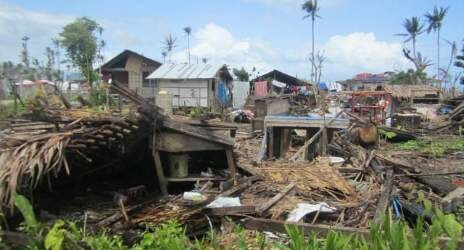
Over 46,000 homes were destroyed, and more than three months on, 46 per cent of those homes remain completely uninhabitable. Twenty five percent of those households affected are living in makeshift homes, and many others are sharing bunkhouses with up to a dozen other families. Providing adequate shelter assistance to all those affected remains a huge challenge.
Following any large-scale disaster, the design of a swift and effective shelter response involves a range of governmental and non-governmental actors (both national and international), and can implicate laws in many different sectors. Longer-term issues, including possible relocation, acquisition of new land and construction of new homes can take months or even years to resolve. While these processes are underway, the displaced may be left in emergency shelter conditions.
In February, the IFRC’s Asia Pacific Disaster Law Coordinator, Tessa Kelly, travelled to the Philippines’ typhoon-affected areas to collect information on the legal and regulatory barriers impacting the Bopha response. She met with representatives from a wide range of government departments, international and local organisations, as well as affected communities.
During one inter-agency meeting, a municipal mayor voiced his frustration at how long procedures to provide emergency and transitional shelter can take. “If you want to delay action,” he exclaimed, “then create committees and sub-committees. Our people cannot wait. Recovery should be swift!”
One of the biggest concerns of both local governments and shelter providers is the identification of hazard prone areas to be declared as ‘No Build Zones.’ With decisions still pending, shelter providers are reluctant to provide transitional or permanent shelter assistance, for fear that recipients may later be evicted or relocated. Other regulatory processes may further slow the response, including requirements to verify land ownership and title. Concerns have been raised as to whether people under informal tenure arrangements will have the same access to shelter assistance as those who are able to evidence documented land title, and whether indigenous groups in remote, hard to access places will also receive much-needed assistance.
Facing these challenges, the Commission on Human Rights of the Philippines (CHRP) is taking action to ensure that people’s human rights are protected in the provision of all post-disaster shelter. Representatives of the CHRP are attending inter-agency meetings and visiting local governments to advise them on key international human rights standards and the government’s obligations under national law. Ms Junitte Rose F. Barroquillo, from the CHRP, had a positive outlook on the opportunities that Bopha may provide. “Typhoon Bopha, without intending it, may actually alleviate the plight of our informal settlers, among others,” she said. Through the promotion of principles of non-discrimination and equitable assistance, Ms Barroquillo explained that “informal settlers will be included in the relocation plans to safe areas, giving them access to better living conditions and arrangements.”